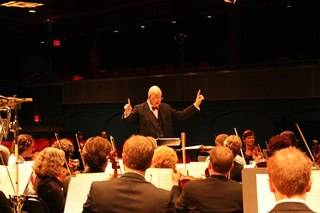|
Back
Notes Uncovered from a Remote Diaspora New York
Isaac Stern Auditorium, Carnegie Hall
11/07/2023 -
Alexandre Tansman: Polish Rhapsody
Josef Tal: Exodus
Walter Kaufman: Indian Symphony
Marcel Rubin: Symphony No. 4, “Dies Irae”
Noam Heinz (Baritone)
The Orchestra Now, Leon Botstein (Founder and Conductor)

L. Botstein
“I regard anti-Semitism as ineradicable and as one element of the toxin with which religion has infected us.”
Christopher Hitchens
“This will be our reply to violence: to make music more intensely, more beautifully, more devotedly than ever before.”
Leonard Bernstein
And yea, in the existing world of horror, hatred and slaughter, then last night did the mighty Leon Botstein raise his staff and direct his people to another time of horror and slaughter, to produce music from that time, and the sounds of timbrel and harp and trumpet give hope that the world today might (unlikely as it may be), survive.
Last night’s performance of The Orchestra Now (TŌN) did indeed return to the first Holocaust. Yet the Holocaust theme was secondary to what I call the “Secret Diaspora”. In this case, Jews who didn’t write and die in the concentration camps. But survived the Nazi terrors by fleeing to other countries and producing their works in relative safety.
Unlike those who died under the Nazi regime. Mr. Botstein’s composers left Poland, Austria, and the Czech state, scattering to international places of refuge. Specifically, their talents were put to use in Mexico, India, France and burgeoning Palestine.
Except to specialists, their names are unfamiliar (The exception, Moise Weinberg, voluntarily left Poland for Russia and didn’t flee, so wasn’t part of last night’s Secret Diaspora.) And with their usual youthful expertise, TŌN gave apparently good readings to these unknowns uncovered by their conductor.
The effects varied vastly, but one biography was stunning. Walter Kaufman joined an émigré group in Bombay (today’s Mumbai), almost certainly taking refuge with the Parsee community. There, he not only formed chamber and symphonic ensembles–but he was Zubin Mehta’s first violin teacher!
Unlike George Harrison, Kaufman had no interest in Indian music (he called it “alien and incomprehensive”), but soon his artistic curiosity inspired him to explore ragas both Hindi and Dravidian. (Hopefully he visited the fascinating ancient Jewish community in Kerala, where I once saw by a lakeside, a five‑century synagogue in the same yard as a five‑century old mosque.)
While that was too his credit, the TŌN’s Indian Symphony was a heavy Germanic picture of Indian music. One could spot the raga motives, the rhythmic changes and, finally some booming percussion. Indian music, though, does not boom or bluster. Mr. Kaufman transformed his scholarly findings into a plaster simulacrum of the “alien” music.
Two other works were composed and performed with all due respect. Alexandre Tansman’s Polish Rhapsody was not exactly a paean to his birthplace, but a call for freedom. Starting with dark chaos, it included parts of the Polish National Anthem, parts of their would‑be savior, God Save the Queen, and the usual Polish dances.

M. Rubin/N. Heinz
Josef Tal’s Exodus was a solo oratorio, written in 1941, the year of the anti‑Jewish edicts, in German, and a time when many Jews took refuge in the British mandate of Palestine. The words, mainly taken from the Biblical Exodus (like last week’s Israel in Egypt) were sung with stentorian bravado by Noam Heinz. The work was heartfelt, competent, yet more a curiosity than a would‑be classic.
The single work which has remained in my mind, which was tragic, funny, euphoric (the successive movements) and brilliantly conceived was the Fourth Symphony by Austrian‑born Marcel Rubin. That Dies Irae symphony made the whole evening more than an engaging curiosity, but an emotive wonder.
Rubin–a student of both Franz Schmidt and Darius Milhaud–started with tragic music for a Bertolt Brecht poem which could have been written for Gaza: Lost children scuttling, hungry... They wanted to fly from the hunger... This with lamenting solos by Concertmaster Yi‑Ting Kuo and violist Michael Holbrook. This movement ending with a whisper of the 13th Century Dies Irae.
The second movement took that prayer and turned it on its head. The Dies Irae could be hysterical, animated (Milhaud would have loved it), doleful and triumphant in turn. Like post‑modern literature, Marcel Rubin extracted sections, turned them upside‑down, merged them with other moments in a quasi-hysterical and always controlled, always jolting movement.
This ending unexpectedly with a final movement of peace. A kind of silent peace. Or truce. Or hopefulness.
Mr. Rubin obviously composed it with the war in mind. Yet this was no political mythos. This 4th Symphony was a creation which always astonished, always moved in places where it should move.
Whether through the TŌN or Mr. Botstein or another conductor, we must hear other works of Marcel Rubin. One performance makes us thirst for more.
Harry Rolnick
|